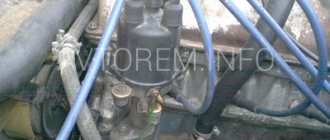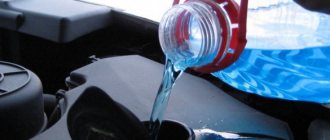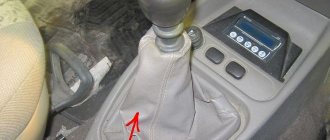Hello, dear friends! Many of those who operate a car have probably encountered a situation where water drips from the exhaust pipe.
At the same time, some immediately begin to panic, believing that such phenomena have serious causes. When starting the engine, the exhaust often steams during warm-up. Moreover, this should not be confused with smoke.
Most often, fumes and water from the exhaust system are clearly visible in winter or autumn, during wet and cold weather. Although it also occurs in summer. But is the formation of vapor clouds and liquid droplets escaping through the exhaust pipe of a vehicle really dangerous?! In reality, everything is not so scary.
The basis of this phenomenon is condensation. It is because of this that water sometimes literally pours, leaving behind a stain on the asphalt. Let's look at the reasons and what needs to be done in such situations.
Possible reasons
First, you need to find out exactly why water can appear and what exactly happens to the car.
Moreover, it doesn’t matter whether you bought a brand new Renault Captur or are using an old VAZ 2114. A characteristic sign in the form of dripping water, which often complements white smoke, is found on any car. That’s why owners of vehicles of various categories turn to forums with similar questions, ranging from old, sometimes even Soviet cars, to developments from leading auto companies, released almost a few months ago.
In most cases, motorists are faced with a simple physical phenomenon called condensation. Its formation is determined by the simplest laws of physics.
But there are cases when water and a large amount of steam indicate serious malfunctions, such as a broken head gasket or even a crack in the cylinder head.
Before thinking about how to remove water from the muffler, let's look at the reasons for its appearance.
All internal combustion engines heat up to very high temperatures during operation. Heat removal is ensured by the presence of a cooling system. In this case, the exhaust tract still remains heated. The intake pipes and exhaust manifold can warm up to 500-700 degrees Celsius, which is due to their location near the engine. And the pipes located a little further, like the muffler with the resonator, do not overheat as much. Although temperatures are still high.
When the engine stops, the steam that appears in the exhaust pipe begins to gradually settle on the inner walls. Steam, as you know, is one of the aggregate states of water.
It is these vapors that gradually turn into ordinary water. This is why, during a cold start, water often comes out of the exhaust, but when the engine is warm, everything goes away, since the high temperature promotes the complete evaporation of accumulated moisture.
How to prevent water from appearing in the muffler
To reduce the level of condensation, it is advisable to perform three steps.
- If you have a garage, do not leave your car outside.
- Fill your car with high-quality fuel. Often, when switching to more expensive fuel or changing gas stations, the amount of condensate formed decreases.
- Make changes to the automatic warm-up settings. In machines with this function, the heating system starts operating at certain intervals. In order for the water to evaporate from the muffler, it is enough to increase the warm-up period.
Insulating the muffler as a way to solve the problem is questionable. Electric heaters are expensive, but they are ineffective.
The liquid heating system is difficult to install, and its installation is often not justified from a practical point of view. Insulation with non-combustible materials only slows down the cooling process of the exhaust pipe body in the car.
Buy a bee trailer for a car: which one is better?
This phenomenon is considered normal for the early spring and autumn-winter periods. Moreover, the most active accumulation of water in the exhaust system occurs precisely when the car is operated for short trips. The old moisture does not have time to evaporate, and at the same time new condensation appears. If you observe something similar that happens after the machine is brought to operating temperature, you should not worry at all. These are natural physical processes.
It’s another matter when, after heating, steam still appears in large volumes. There is no need to talk about black or blue smoke at all. This is a slightly different category.
The motorist should pay attention not only to the color of the liquid, but also to the nature of the smoke. I'll tell you more about this a little later.
And so, the engine has warmed up, but clouds of steam still come out of the pipe. Here you should pay attention to the following signs of a possible malfunction:
What to do if condensation appears in the car exhaust pipe
Climatic conditions and the operating principle of the internal combustion engine cause the formation of condensed steam in the exhaust gas exhaust system. To evaporate it, it is enough to take a long trip lasting more than an hour once a week.
You need to go to a service station for diagnostics if the exhaust gases have bluish or black smoke, a large amount of soot settles on the walls of the pipe, or there are malfunctions in the functioning of the cooling system or engine.
Is it possible to drill a muffler?
The procedure is ambiguous. On the one hand, liquid is removed from the exhaust system through the holes, on the other hand, two problems arise:
- the exhaust sound becomes louder;
- an element made of ordinary steel fails prematurely.
Under the influence of high temperatures, reagents, and moisture, a small hole will steadily increase. The same thing will happen with a stainless steel part, but at a slower pace.
Note: How and how to paint car rims yourself
Instead of drilling into the muffler, experts recommend that car owners create conditions that will prevent the formation of condensed steam in significant quantities.
Registering a trailer through government services: step-by-step instructions
- Coolant is boiling in the expansion tank. Not the best sign, the reasons for which vary;
- In the same expansion tank, the fluid level drops. Moreover, after adding coolant, it disappears again in a short period of time;
- If you over-gas, a thick cloud of steam comes out of the exhaust, which is accompanied by drops of moisture;
- The temperature sensor is triggered and reports overheating of the power plant.
An unpleasant situation that often requires disassembling the cylinder block and removing its head. It's hard not to notice a broken gasket.
In addition to violating the integrity of the cylinder head gasket, deformation of the contact surface between the block and its head cannot be ruled out.
Note the smoke and color of the liquid
We have already found out that with a cold engine while the engine is warming up, there is nothing wrong with the appearance of water and white smoke. This is just steam, which will soon evaporate completely and stop dripping from the pipe.
But it happens that the character of the smoke is completely different, dark or bluish in color. At the same time, not just water flows out, but some kind of black liquid. Sometimes motorists note that the color of the water is yellow.
It is worth considering all these situations and possible reasons for their occurrence.
What is the difference between an SUV and a crossover and SUV: what to choose
- Blue smoke and dark liquid color. If the clouds of smoke are thick and characterized by this color, then the elements of the cylinder-piston group have probably worn out and the piston rings have become stuck. You urgently need to contact an experienced mechanic;
- The smoke is black and the liquid is of a similar color. Here you will have to check the condition of the fuel system. Excessive consumption of fuel occurs, fuel is mixed with oil due to a violation of the integrity of connections, gaskets, etc.;
- Gray but weak smoke is most often associated with hardened valve stem seals. They will have to be changed. If you have a turbo engine, then it is possible that the turbocharger itself may break down.;
- Yellow color of water. The situation here is ambiguous. Many motorists claim that the yellow color is due to the coloring of fuel at some gas stations. This is quite consistent with reality, so this option should not be ruled out. Or the exhaust system has rusted from the inside, that is, yellow water is a banal consequence of rust formation.
There is nothing good about black smoke. In the vast majority of cases, fuel burns poorly or incorrectly. The reasons themselves may lie in pinched valves, clogged injectors, a broken carburetor, a clogged air filter, a broken high-pressure pump, etc.
Do-it-yourself repair of chips and cracks on the windshield: affordable methods
If you are concerned about the presence of water droplets and white smoke (steam), but there are no other signs of engine problems, there is no need to worry. If desired, you can follow a few simple rules so that condensation occurs in a smaller volume.
To reduce steam output you can:
- periodically travel not only short distances, but also carry out long trips;
- make a hole in the resonator through which condensate will escape;
- Give it a good throttle when the engine is warm, then turn it off.
By the way, on some cars a drain hole is provided from the factory. There is no need to drill anything additional here.
And I’ll say a few more words regarding the freezing of water in the exhaust system. If ice forms in narrow passages, then the exhaust removal process will be disrupted, the engine will no longer start normally or will stall.
Freezing of the muffler due to the accumulation of condensate in it
If the car is left in an open parking lot in the cold in winter, a lot of moisture can accumulate in the exhaust system, and water often freezes in a low elbow and in a narrow place. As a result, ice blocks the passage of exhaust gases, problems arise with starting the internal combustion engine - the car will start, then immediately stall. In such cases, it is necessary to warm up or tap (clean) the exhaust tract, but in general there are several solutions:
- try to clean the pipe if ice has formed at the back (not in the elbow between the cans);
- tow the car to a warm garage or service station;
- warm up the “outlet” using a hair dryer;
- use the services of visiting specialists;
- take the car to a car wash to warm up the muffler using hot water.
Heating with an open flame (gas burner, blowtorch, etc.) is not recommended; all other methods can be considered.
And in order to avoid the repetition of such cases, holes must still be made in the muffler, you should also gas the car to blow out condensation before parking, do this also when starting the car, park the car not on a descent, but on an ascent. Video - Water drips from the muffler:
Related articles:
- Gasoline and diesel engines Renault Duster Despite the fact that the Renault Duster crossover is a budget option, its reliability is not inferior to cars of a higher price category. The power […]
- Carburetor VAZ 2109: design, configuration, adjustment Cars of models 2108-09 are truly legendary developments of the Volga Automobile Plant, it was with them that the production of front-wheel drive passenger cars began in the USSR. Also for these cars […]
- Advantages and disadvantages of the VAZ-11113 Oka The subcompact compact car VAZ 11113 “Oka” is somewhat unique - there are practically no such miniature cars in Russia anymore. With its technical characteristics [...]










